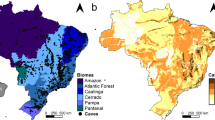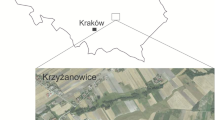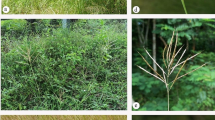Abstract
The second part of the study is connected with the first part which comprised all the available data concerning the distribution ofRhynchospora alba in Czechoslovakia. It presents the results of cenological and synecological research, summarizes the cenotic and habitat characteristics of the species and, on the basis of results thus obtained, attempts at evaluating the diagnostic value ofRhynchospora alba and syntaxonomic position of its communities.
Similar content being viewed by others
Literature cited
Bellot Rodriguez, F. (1966): La Vegetation de Galicia.—An. Inst. bot. A. J. Cavanilles, Madrid, 24: 1–306.
Bogdanovskaja-Gienev, J. D. (1928): Rastitelnyj pokrov verchovych bolot russkoj Pribaltiki. (Die Vegetation der Hochmoore des russischen Ostbaltikums).—Trav. Inst. Sci. nat. Peterhof, Leningrad, 5: 265–377.
Booberg, G. (1930): Gisselasmyren. (Das Gisselasmoor).—Norrländ. Handbibl., Uppsala, 12: 1–330.
Braun-Blanquet, J. (1964): Pflanzensoziologie. 3. Aufl.—Wien.
Czubiński, Z. et al. (1954): Bielawskie Błoto—gin≸ce torfowisko atlantyckie Pomorza. (Bielawskie Błoto—a disappearing peatbog of the Atlantic type in Pomerania).— Ochrona Przyrody, Kraków, 22: 67–159.
Du Rietz, G. E. (1949): Huvudenheter och huvudgränser i svensk myrvegetation. (Main units and main limits in Swedish mire vegetation).—Svensk bot. T., Uppsala, 43: 274–309.
Fijałkowski, D. (1960): Szata roślinna jezior Leczyńsko-Włodawskich i przylegajacych do nich torfowisk. (Plant associations of lakes between Leczyna and Włodawa).—An. Univ. M. Curie-Skłodowska, Lódż, Ser. B, 14: 131–206.
Fischer, W. (1960): Pflanzengesellschaften der Heiden und oligotrophen Moore der Prignitz. —Wiss. Z. pädagog. Hochsch. Potsdam, math. naturw. R., 6: 83–106.
Gams, H. etRuoff, S. (1929): Geschichte, Aufbau und Pflanzendecke des Zehlaubruches. Monographie eines wachsenden Hochmoores in Ostpreussen.—Schr. phys.-ökon. Ges. Königsberg, 66: 3–192.
Géhu, J. M. etWattez, J. R. (1965): Notes sur la vegetation des marais de la plaine maritime picarde.—Bull. Soc. bot. nord France, Lille, 18: 144–163.
Godwin, H. etConway, V. M. (1939): The ecology of a raised bog near Tragaron, Cardiganshire. —J. Ecol. Cambridge, 27: 313–359.
Görs, S. (1961): Das Pfrunger Ried. Die Pflanzengesellschaften eines oberschwäbischen Moorgebietes.—Veröff. Landesst. Natursch. Landschaftspflege Baden-Würtemberg, Ludwigsburg, 27–28: 5–45.
Grosser, K. H. (1963): Die Moor-und Bruchgesellschaften.—InScamoni, A. et al.: Natur, Entwicklung und Wirtschaft einer jungpleistozänen Landschaft, dargestellt am Gebiet des Messtischblattes Thurow (Kreis Neustrelitz), I.—Wiss. Abh. DAL, Berlin, 56: 1–340.
Hadač, E. (1939): Zur Nomenklatur und Systematik der Moorgesellschaften.—Stud. bot. čech., Praha, 2: 97–106.
Hadač, E. (1964) inBřezina, P. et al.: Poznámky o vegetaci Třeboňských blat. (The observation of the vegetation of the Třeboň mires.)—Sborn. pedagog. Inst. Plzeň, zemèp.— přírod., 4: 207–272.
Holub, J., Hejný, S., Moravec, J. etNeuhäusl, R. (1967): Übersicht der höheren Vegetationseinheiten der Tschechoslowakei.—Rozpr. čs. Akad. věd, Ř. mat. přír. věd, Praha, 77: 1–75.
Ilschner, G. (1959): Die Pflanzengesellschaften des Wurzacher Riedes. Zur Systematik, Ökologie und Kenntnis des Vegetationsgefüges von Moorgesellschaften.—Ms., Dissert., Tübingen.
Jahns, W. (1962): Zur Kenntnis der Pflanzengesellschaften des Grossen und Weissen Moores bei Kirchwaldsede (Krs. Rotenburg-Hann).—Mitt. flor.-soz. Arbeitsgem., Stolzenau, N. F. 9: 88–94.
Jahns, W. (1969): Torfmoos-Gesellschaften der Esterweger Dose.—Schriftenreihe Vegetationskunde, Bad Godesberg, 4: 49–74.
Jasnowski, M., Jasnowska, J. etMarkowski, S. (1968): Ginące torfowiska wysokie i przejściowe w pasie nadbałtyckim Polski. (Vanishing raised and transition peat bogs in the Baltic region of Poland.)—Ochrona Przyrody, Kraków, 33: 69–124.
Jeschke, L. (1963): Die Wasser- und Sumpfvegetation im Naturschutzgebiet “Ostufer der Müritz”.—Limnologica, Berlin, 1: 475–545.
Jonas, F. (1935): Die Vegetation der Hochmoore am Nordhümmling, I.—Beih. Repert. Spec. nov. Regni vegetab., Dahlem, 78 (1): 1–143.
Jurko, A. etPeciar, V. (1959): Zpráva o výskume rašeliniska pri Suchej Hore na Orave. (Bericht über die Erforschung des Torfmoores bei Suchá Hora in Orava.)—Acta Facult. Rerum natur. Univ. Comenianea, Bot., Bratislava, 3: 469–508.
Kästner, M. etFlössner, W.: Die Pflanzengesellschaften des erzgebirgischen Moore.— Dresden.
Klika, J. (1935): Příspěvek k poznání rostlinných společenstev na rašelinách—svazRhynchosporion. (Ein Beitrag zum Erkennen der Pflanzengesellschaften auf Mooren in ČSR—derRhynchosporion-Verband.)— Sborn. čs. Akad. zeměd., Praha, 10: 118–124.
Klika, J. (1955): Nauka o rostlinných společenstvech. (Vegetationskunde.)—Praha.
Klika, J. (1958): K fytocenologii rašelinných a slatinných společenstev na Záhorské nížině. (Zur Phytozönologie von Torf-und Moorgesellschaften auf der Záhorskaer Tiefebene.)— Biol. Pr., Bratislava, 4 (4): 1–34.
Koch, W. (1926): Die Vegetationseinheiten der Linthebene unter Berücksichtigung der Verhältnisse in der Nordostschweiz.—Jb. St. Gall. naturf. Ges., St. Gallen, 61 (2): 1–146 (sep.)
Krausch, H.-D. (1968): Die Pflanzengesellschaften des Stechlinsee-Gebietes. IV. Die Moore.—Limnologica, Berlin, 6: 321–380.
Kubiëna, W. (1953): Bestimmungsbuch und Systematik der Böden Europas.—Stuttgart.
Larsson, B. (1960): Bidrag till Västergötlands mossflora. (Contribution to the Bryophyte flora of Västergötland.)—Svensk bot. T., Uppsala, 54: 423–438.
Malmer, N. (1962): Studies on mire vegetation in the Archaean area of Southwestern Götaland (South Sweden), I.—Opera bot. Soc. bot. suec., Lund, 7 (1): 1–322.
Mattauch, F. (1936): Ein Beitrag zur Kenntnis der Verlandungserscheinungen am Hirschberger Grossteiche.—Beih. bot. Cbl., Dresden, Abt. B. 54: 377–426.
McVean, D. N. etRatcliffe, D. A. (1962): Plant communities of the Scottish Highlands.—London.
Moore, J. J. (1968): A classification of the bogs and wet heaths of Northern Europe.—In: Pflanzensoziologie und Palynologie, Ber. intern. Sympos. Stolzenau-Weser 1964, Den Haag, 306–320.
Moravec, J. (1965): Wiesen im mittleren Teil des Böhmerwaldes (Šumava).—Vegetace ČSSR, Praha, A1: 181–385.
Moravec, J. etRybníčková, E. (1964): DieCarex davalliana-Bestände im Böhmerwaldvorgebirge, ihre Zusammensetzung, Ökologie und Historie.—Preslia, Praha, 36: 376–391.
Mörnsjö, T. (1969): Studies on vegetation and development of a peatland in Scania, South Sweden.—Opera bot., Lund, 24: 1–187.
Neuhäusl, R. etNeuhäuslová, Z. (1965): Rostlinná společenstva státní přírodní reservace Břehyňský rybník u Doks. (Die Pflanzengesellschaften des Naturschutzgebietes “Břehyňský rybník” bei Doksy.)—Preslia, Praha, 37: 170–199.
Nordhagen, R. (1936): Versuch einer neuen Einteilung der subalpinen Vegetation Norwegens. —Bergen Mus. Arbok, natturvid. R., Bergen, 7: 1–88.
Nowiński, M. (1930): Roślinność i znaczenie dla rolnictva torfowisk niskich z okolic Wisłoka do Sann, w południowo-wschódniej części dawnej puszczy Sandomierskiej. (La végetation et l'importance pur l'agriculture des basses tourbieres de la région situeé à l'embouchure du Wisłok dans le San, dans la partie sud-est de l'ancienne grande Forêt de Sandomierz.)— Pr. roln.-leśne PAU, Kraków, 3: 31–89.
Oberdorfer, E. (1957): Süddeutsche Pflanzengesellschaften.—Pflanzensoziologie, Jena, 10.
Osvald, H. (1923): Die Vegetation des Hochmoores Komosse.—Svensk växtsociol. Sällsk. Handl., Uppsala, 1: 1–436.
Passarge, H. (1964): Pflanzengesellschaften des norddeutschen Flachlandes I.—Pflanzensoziologie, Jena, 13.
Paul, H. etLutz, J. (1941): Zur soziologisch-ökologischen Charakterisierung von Zwischenmooren. —Ber. bayer. bot. Ges., München, 25: 5–32.
Poelt, J. (1954): Moorgesellschaften im Alpenvorland II.—Sitzungsber. öst. Akad. Wiss., Wien, mathem, naturw. Kl., Abt. 1, 163 (6–7): 495–439.
Poore, M. E. D. (1955): The use of phytosociological methods in ecological investigations I.—J. Ecol., Cambridge, 43: 226–244.
Ramenskaja, A. M. (1958): Lugovaja rastitělnost Karelii. (The meadow vegetation of Karelia).—Petrozavodsk.
Ratcliffe, D. A. (1964): Mires and bogs.—InBurnett et al.: The vegetation of Scotland.— Edinburgh, p. 426–459.
Runge, F. (1967): Vegetationsschwankungen imRhynchosporetum.—Mitt. flor.-soz. Arbeitsgem., Todenmann/Rinteln, N. F. 11/12: 49–53.
Ruuhijärvi, R. (1960): Über die regionale Einteilung der nordfinnischen Moore.—An. Soc. zool. bot. fenn. Vanamo, Helsinki, 31 (1): 1–306.
Rybníček, K. (1964): Die Braunmoorgesellschaften der Böhmisch-Mährischen Höhe (Tschechoslowakei) und die Problematik ihrer Klassifikation.—Preslia, Praha, 30: 403–415.
Rybníček, K. (1970):Rhynchospora alba (L.)Vahl, its distribution, communities and habitat conditions in Czechoslovakia—Folia geobot. phytotax., Praha, 5: 145–162.
Schwickerath, M. (1940): Aufbau und Gliederung der europäischen Hochmoorgesellschaften. —Bot. Jb., Berlin, 71: 249–266.
Schwickerath, M. (1942): Bedeutung und Gliederung des Differentialartenbegriffes in der Pflanzengesellschaftlehre.—Beih. bot. Cbl., Dresden, Abt. B. 61: 351–383.
Segal, S. (1966): Ecological studies of peat-bog vegetation in the North-western part of the province of Overijsel (the Netherlands).—Wentia, Amsterdam, 15: 109–141.
Sjörs, H. (1948): Myrvegetation i Bergslagen. (Mire vegetation in Bergslagen, Sweden.)— Acta phytogeogr. suec., Uppsala, 21: 1–300.
Sjörs, H. (1950): On the relation between vegetation and electrolytes in North Swedish mire waters.—Oikos, Lund, 2: 241–258.
Spence, D. H. N. (1964): The macrophytic vegetation of freshwater lochs, swamps and associated fens.—InBurnett et al.: The vegetation of Scotland.—Edinburgh, p. 306–381.
Stamer, R. (1967): Vegetationskundliche Untersuchungen an Schlatts der Osenberge und des Ahlhorner Forstes.—Mitt. flor.-soz. Arbeitsgem., Todenmann/Rinteln, 11/12: 28–47.
Steffen, H. (1931): Vegetationskunde von Ostpreussen.—Pflanzensoziologie, Jena, 1.
Tüxen, J. (1969): Gedanken über ein System derOxycocco-Sphagnetea Br.-Bl. etTx. 1943.— Vegetatio, Den Hague, 19 (1–6): 181–191.
Tüxen, R. (1937): Die Pflanzengesellschaften Nordwestdeutschlands.—Mitt. flor.-soz. Arbeitsgem. Niedersachs., Hannover, 3: 1–170.
Tüxen, R. (1962): Der Maujahn. Skizze der Pflanzengesellschaften eines wendländischen Moores.—Veröff. geobot. Inst. Rübel Zürich, Bern, 37: 267–302. (Festschrift Franz Firbas.)
Tüxen, R. etOberdorfer, E. (1958): Die Pflanzenwelt Spaniens 2. Eurosibirische Phanerogamen-Gesellschaften Spaniens mit Ausblicken auf die alpine und Mediterran-Region dieses Landes.—Veröff. geobot. Inst. Rübel Zürich, Bern, 32: 1–328.
Traczyk, T. (1962):Caricetum limosae Br.-Bl.1921 na terenie nadleśnictwa Tereszpol, Kotlina Sandomierska. (Caricetum limosae Br.-Bl. 1921 in Tereszpol forest administration district, Sandomierz lowland.)—Ekol. pol., Warszawa, Ser. B. 8: 299–305.
Vanden Berghen, C. (1951): Landes tourbeuses et tourbiéres bombées à Sphaignes de Belgique.—Bull. Soc. royale bot. Belg., Bruxelles, 84: 157–226.
Vicherek, J. (1958): Rostlinná společenstva rašelinných luk u Vidnavy. (Die Pflanzengesellschaften der Moorwiesen bei Weidenau.)—Přírod. Sborn. ostrav. Kraje, Opava, 19: 185–221.
Vollmar, F. (1947): Die Pflanzengesellschaften des Murnauer Moores.—Ber. bayer. bot. Ges., München, 27: 13–97.
Author information
Authors and Affiliations
Rights and permissions
About this article
Cite this article
Rybníček, K. Rhynchospora alba (L.) Vahl, its distribution, communities and habitat conditions in Czechoslovakia, Part 2. Folia geobot. phytotax. 5, 221–263 (1970). https://doi.org/10.1007/BF02851924
Received:
Issue Date:
DOI: https://doi.org/10.1007/BF02851924




